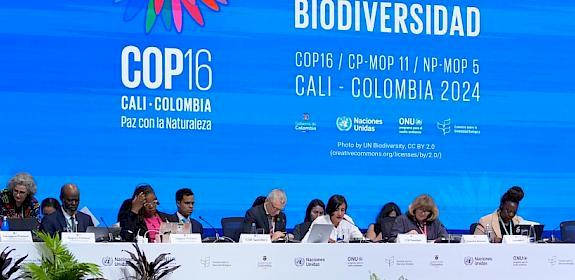
Supporting action towards an assessment of how CITES can contribute to the implementation of the Global Biodiversity Framework and its monitoring framework while ensuring the sustainability, legality and safety of harvest, use and trade of wild species.
In May 2019, the Inter-governmental Science Policy Platform on Biodiversity and Ecosystem Services (IPBES) Global Assessment Report on Biodiversity and Ecosystems Services found that around one million animal and plant species are now threatened with extinction and that the rate of species extinctions is accelerating. The report identified direct exploitation of animal and plant species as the second most significant driver of negative impacts on nature after changes in land and sea use. More recently, in July this year, the Sustainable Use of Wild Species Assessment Summary for Policymakers said that the interconnectedness of global trade in wild species is a significant driver of the increased and often unsustainable use of wild species. About 50,000 wild species of animals, plants and fungi are used for food, energy, medicine, material and other purposes.
With wildlife use and trade now so prominent in the biodiversity agenda, for the first time, the draft Post-2020 Global Biodiversity Framework now includes targets related to wildlife trade. This includes one concerning the sustainability, legality and safety of wildlife harvest, use and trade (Target 5) and another on the contribution of the use of wild species to multiple benefits to people (Target 9). The framework will be the focus of discussions at the 15th Meeting of the Conference of the Parties to the Convention on Biological Diversity (CBD) that will take place in Montreal in December 2022.
For the Post-2020 Global Biodiversity Framework to meet its ambitious targets by 2030, it is imperative, alongside the global commitment and political will, to adopt a clear monitoring framework, ensure resources for the implementation of interventions and track progress made towards the targets. Without a robust monitoring framework for these targets, the international community will be doomed to repeat the results of the Global Biodiversity Outlook (GBO-5), which suggested that none of the 20 Aichi biodiversity Targets were fully met by the target date of 2020.
As the Convention is responsible for ensuring that international trade in specimens of wild animals and plants does not threaten the survival of the species, CITES has a unique role to play in contributing to ensuring that these targets are met. At the 18th meeting of the Conference of the Parties to CITES in 2019, Parties adopted Resolution Conf. 18.3 on the CITES Strategic Vision: 2021-2030, which fully recognises that CITES may provide benefit to, and draw strength from, and highlight their linkages with other international biodiversity efforts, such as the Post-2020 Global Biodiversity Framework.
TRAFFIC, therefore, fully supports the draft Decision to be discussed at CITES CoP19 in document CoP18 Doc. 10 on ‘CITES Strategic Vision’ calling on the Secretariat to undertake a comparative analysis in order to illustrate the linkages between the CITES Strategic Vision 2021-2030 and highlight areas of alignment with the Post-2020 Global Biodiversity Framework, as a starting point for an assessment of how CITES can contribute to the implementation of the Global Biodiversity Framework and its monitoring framework. The Animals, Plants and Standing Committees are also being asked to review this analysis and make further recommendations that will be discussed at the 20th meeting of the Conference of the Parties.
This work would be an important opportunity to ensure that the indicators being used by the CITES Strategic Vision and Post-2020 Global Biodiversity Framework are consistent, harmonised, and mutually supportive of each other. This will reduce the reporting burden for the Parties by ensuring that the indicators developed for the CITES Strategic Vision are also used for purposes of reporting to the framework.
Monitoring systems for the development and monitoring the progress of such indicators will require support if countries are to utilise them effectively. We would therefore call on Parties to provide the technical and financial support and resources needed, as well as establish clear and structured mechanisms to support countries in building capacity for their monitoring systems. In this regard, TRAFFIC also welcomes the draft Decision in Doc. CoP19 Doc. 7.5 on ‘Access to Funding’, encouraging Parties to monitor the progress of establishing the Wildlife Conservation for Development Integrated Program under the eighth replenishment of resources for the Global Environment Facility’s Trust Fund (GEF-8). This will ensure that national projects under GEF-8 can enhance their ability to meet their obligations under both CITES and the post-2020 global biodiversity framework.
Given the importance of the use of wild species nationally, it is critical that measurement of progress in tackling unsustainable use is measured at the national level before it can be reflected in global indicators. TRAFFIC, therefore, encourages governments to develop indicators which are nationally based that can be relevant to the measurement of progress at the international level but also effectively address biodiversity challenges they face at the national level.
As a long-established organisation working primarily on wildlife trade, TRAFFIC is ready and committed to assisting governments and mobilising action to ensure they meet their commitments to effectively implementing both CITES and the Post-2020 Global Biodiversity Framework. For example, TRAFFIC is working with a range of Parties and international organisations – including the Collaborative Partnership on Sustainable Wildlife Management, to which the CITES Secretariat is a partner - in efforts for the co-development of the indicator 'Sustainable Use of Wild Species' to measure the implementation of the draft Target 5 of the Post-2020 Global Biodiversity Framework, and is keen on working with CITES Parties in ensuring strong linkages between these and their CITES obligations.
global biodiversity agenda
TRAFFIC publications related to the global biodiversity agenda.






